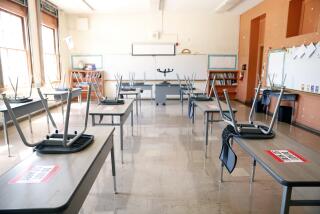Gripe
- Share via
I recently substituted at the John Muir Middle School. I was depressed by the poor achievement and behavior of the students in my classroom. In discussion with students, teachers and administrators, I discovered part of the problem was the many vacant teacher positions.
My students were, by and large, unruly and abusive. In each class, there were a few well-behaved and productive pupils, but the majority were not. Several students argued with me when I asked them to work on the assignment. One group sang all during the class period. Another group persisted in writing their names on their backpacks with “White-Out.” I called security three times in one day. In one class they removed three students. In another class a promised visit by the dean never materialized. On two daily assignments, there were no roll sheets or lesson plans left for the substitute; another teacher provided me with suitable materials.
In talking with other teachers, I found that most of them were also substitutes. One was a substitute for a long-term ill substitute. They spoke of similar situations in other neighborhood schools.
Students in my classes said that they had not had a permanent teacher in several weeks. An administrator at the middle school asked me to sub on a long-term basis. Because of my chaotic subbing experience, I declined. Teacher morale seemed very low with many complaints of excessive student load and poor student behavior.
I am sure there are many positive learning activities going on. But my experiences, admittedly brief and temporary, indicate that there are significant problems of teacher vacancies that have a severe negative impact on the learning environment in many inner-city schools.






